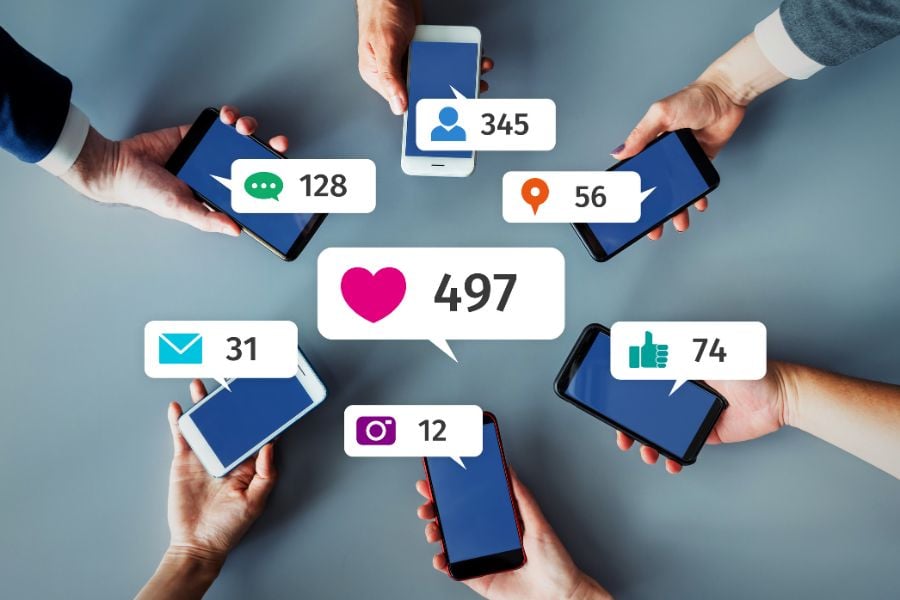What is social listening and can it really be a game-changer for your online presence?
Imagine not only hearing what your customers are saying, but truly understanding their needs, wants, and concerns.
With specific strategies and actionable techniques, you can transform online chatter into powerful insights that win hearts and minds.
In this guide, you will learn the fundamentals of social listening, along with practical tips that pack a punch.
Excited about being the brand your customers love talking about?
Let’s do this!

What is Social Listening?
In the simplest terms, social listening is the process of monitoring digital conversations to understand what customers are saying about a brand and industry online.
Imagine being a mind-reader, knowing what your customers want even before they say it.
Sounds magical, right? That’s precisely what social listening brings to the table.
It allows brands to step out of their echo chambers and tap into the customer pulse.
It’s about grasping not just the spoken words, but the unspoken sentiments, the praise not sung aloud, and the complaints murmured in hushed undertones.
Think of social listening like a radar, always on, scanning the vast digital landscape for mentions of your brand, competitors, or anything related to your industry.
It’s not just about monitoring posts or likes, but interpreting the insights behind them.
Now, this might sound quite similar to social monitoring. But, don’t get them tangled up!
Social monitoring is akin to firefighting — dealing with individual comments, complaints, or messages as they come.
On the other hand, social listening is like city planning — you’re looking at data over a period to spot trends, gauge sentiment, and get a holistic view of your brand’s digital footprint.
In short, monitoring deals with the present, smaller-picture view, while social listening takes the big-picture view and plans for the future.
The Crucial Types of Social Listening

Broadly, social listening falls into three main categories: brand monitoring, competitor analysis, and industry insights.
It’s like having a triple-layered radar, picking up all the critical signals from your brand, your competitors, and the industry at large.
So let’s dig into these layers, shall we?
Brand Monitoring
Brand monitoring, the first layer of social listening, is like your brand’s annual health check-up.
It’s the act of keeping a close ear on the digital conversations around your brand.
You might think you know what’s going on, but let’s face it, sometimes we’re too close to see the full picture.
Just like a check-up can reveal that you’re not eating enough leafy greens, brand monitoring can unearth hidden insights.
Maybe your customers love your product but find the customer service a tad slow? Or perhaps they love your content but wish you posted more often?
These whispers on the web, if tapped into, can help you fine-tune your brand messaging, align your strategies better with customer expectations, and boost your overall brand health.
Competitor Analysis
The second layer, competitor analysis, is like deploying a spy in the enemy camp.
It’s all about snooping around your competitors to figure out what they’re up to.
Are they launching a new product? Have they changed their marketing strategy? How are their customers responding? Or even better, are their customers unhappy about something?
These nuggets of information, gleaned from the digital chatter, can be your goldmine.
Using this knowledge, you can anticipate market shifts, carve out your unique strategy, and most importantly, avoid the pitfalls your competitors have fallen into.
Industry Insights
The third layer, industry insights, is your window to the future.
In the fast-paced digital world, trends rise and fall faster than you can tweet about them. Being on top of these trends can give you a serious edge over your competitors.
Are people going gaga over a new social media feature? Is there a shift in consumer preferences in your industry? Or is there a sudden spike in interest for a certain type of product?
Catching these waves early on can help you tweak your strategies, innovate your offerings, and surf the tide of opportunity.
In essence, social listening is like having your ear to the ground, picking up all the subtle signals from your brand, your competitors, and the industry.
It’s about listening, learning, and leveraging these insights to navigate the digital landscape better.
So, ready to crank up the volume?
How to Get Started with Social Listening in 3 Super Simple Steps

Setting up social listening might feel like navigating a labyrinth, but it’s actually easier than it sounds.
Here’s how you can traverse this maze with ease…
1. Set Clear Goals & Know Your ‘Why’
First things first, you need to know why you’re embarking on this journey.
What do you want to achieve with your social listening strategy? Are you aiming for better customer service? Perhaps you’re looking to increase engagement or do a deep dive into competitor analysis?
Your ‘why’ forms the foundation of your social listening strategy. The clearer your goals, the more precise your listening, and the sharper your insights.
So, before you plunge into the ocean of digital chatter, take a moment to define your purpose.
2. Choose the Right Channels
Now, you know why you’re listening. The next question is, where should you listen?
Not every platform that’s abuzz with chatter is relevant to your brand. Picture it like this — if you’re selling skateboards, you wouldn’t go looking for customers in an opera house, would you?
Take stock of where your audience hangs out.
Are they tweeting their hearts out on Twitter, or are they more into the polished world of LinkedIn? Perhaps they’re expressing their creativity on Instagram or TikTok?
Pick your channels wisely because it’s not about being everywhere; it’s about being where it matters.
3. Decide What to Listen for
Lastly, what should you listen for?
From your brand and product names to industry buzzwords and trending topics, the list is as vast as the internet itself.
But here’s the thing — you’re not trying to hear everything, you’re trying to hear what’s important.
Think of it like tuning a radio. You don’t want the static noise; you want the sweet melody that strikes a chord.
So, make a list of what to listen for — brand mentions, competitor names, industry keywords, customer complaints, or praises. The more focused your listening, the sharper your insights will be.
Remember, setting up social listening isn’t about diving head-first into the digital chatter. It’s about knowing your ‘why’, choosing your ‘where’, and fine-tuning your ‘what’.
What Key Metrics Should You Track for Social Listening?

Now that you know the basics of social listening, how do you build on the start you have made? With numbers and metrics of course!
Numbers tell a story, and in the world of social listening, they’re your guiding star.
But not all metrics are created equal.
Some offer superficial insights, while others dig deep, giving you a clear picture of your social listening success.
Let’s look at the key metrics that should be on your radar…
Brand Sentiment
Brand sentiment is a critical measure, allowing you to proactively address any potential brand image crises and celebrate positive trends.
To calculate brand sentiment, you need to divide the number of positive mentions of your brand by the total number of mentions, and then multiply the result by 100 to get a percentage.
You can use social listening tools like Hubspot or Buzzsumo to filter out these mentions.
Alternately, sentiment analysis software like IBM Watson Tone Analyzer can help you determine whether a mention is positive, negative, or neutral.
Share of Voice
An increased share of voice equals a stronger market presence and a louder voice in your industry’s conversations.
But what is share of voice, exactly?
Calculating your share of voice involves dividing the number of conversations about your brand by the total number of conversations in your industry (multiplied by 100 to get a percentage).
And how can you get these figures?
Use tools to help track conversations about your brand and your competitors.
Engagement Rate

Remember, an engaged audience is not just watching — they’re participating, advocating, and influencing others. And the metric you use to measure this is called the engagement rate.
To calculate the engagement rate, take the total engagement (likes, comments, shares, etc.) your content receives, divide it by the total number of followers, and multiply it by 100 for a percentage.
Social Listening Return On Investment (ROI)
ROI is not always about the direct dollar return but also about the health and longevity of your brand. Quantifying the return on social listening can be a bit tricky, but it’s crucial.
Start by identifying key outcomes like increased customer satisfaction or reduced complaint volume.
Next, assign a monetary value to these outcomes (think of the cost savings from reduced customer churn or the value of a customer referral).
Now, subtract the cost of your social listening efforts (tools, time, etc.) from these benefits.
Response Rate
Imagine social listening as a conversation. If someone talks to you, they expect a response, right?
The same goes for your brand. Your response rate is the number of customer comments, queries, or mentions that get a response divided by the total number of comments.
Tools like Sprout Social can help monitor and respond to these interactions.
A high response rate means you’re not leaving your customers hanging — you’re engaging with them, acknowledging their input, and building stronger relationships.
Audience Growth Rate
Your audience growth rate measures how fast you’re growing your follower base on social media.
To calculate it, take the number of new followers gained in a specific period, divide it by your total followers at the start of that period, and multiply by 100.
A higher growth rate means your brand is getting more visibility and your voice is reaching more people. It’s a sign your content is resonating, and your brand is making waves.
As you can see, there’s more to social listening than meets the eye. It’s not just about damage control or averting PR disasters. It’s about turning the tide in your favor.
Embrace the Power of Social Listening
Feeling overwhelmed by the online chatter? We get it.
Tapping into the social buzz might seem like finding a needle in the haystack, but hang tight.
Social listening is your secret weapon to cut through the noise. It’s like a backstage pass to your audience’s minds.
And guess what? You’ve got the know-how now.
Go ahead, lean into those conversations, hear the unspoken, and let your brand shine!
The post Social Listening 101: How to Win Hearts (& Minds Online) appeared first on Smart Blogger.

No comments:
Post a Comment